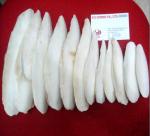In Son La, the Mong people have a large population, accounting for 13%, behind the Thai and the Kinh. They have 3 groups: Flower buttocks, Black buttocks and White buttocks. In the traditional economy, Mong people have a number of unique traditional handicrafts, effectively serving the daily life of the people, contributing to preserving the national cultural identity still reserved until the day. Now such as: Linen weaving, wax pattern printing, blacksmithing, making carpentry ... and a profession that its products are indispensable in the spiritual life of the people. It is craft paper making.
 |
| H'mong paper making techniques exist for at least 300 years |
Paper is usually made during leisure time, especially on the occasion of Lunar New Year when people make paper to celebrate New Year, make a New Year's celebration paper. People often make paper in the dry season, the sun can only dry the paper, new paper is white and beautiful. Paper making is primarily undertaken by women, with no high technical requirements. Mong people often use paper making materials such as stalks, young bamboos, straw ... which are many types of materials where they reside.
The process of making paper types varies slightly. Stubby paper is made from the bark of the stalk, the tree is tightly cut to remove the bark into the cooking pot (it is possible to use fresh or even dry bark). millet and wooden bar beat carefully to remove the peel like a cotton ball. In the process of stirring occasionally, stir in a little ash, which makes it easy to remove the peel and detergent to make the paper white and smooth. The better the dam, the more smooth the paper is, then beat it into a bamboo or pot tube, pour the water thoroughly to stir the sheet to dissolve it. Paper coated mold is placed down in a puddle, encroaching the mold surface, pouring pots to face the mold, using a light hand to spread the sheet to spread the face. Use a bamboo stick to beat lightly on the water to allow the sheet to settle down on the mold surface, just do like it is about 15 minutes. Take 2 hands to support one end of the mold, lift it slightly up from the water so that the sheet is not pushed, when the whole face has been lifted off the water, lift it to the drying yard, let it tilt 45o for quick drain. Paper drying time is about 2 hours. According to the experience of the compatriots, as long as the dry mold cloth is dry paper, use 2 hands to lightly bend 2 corners on the top of the mold, remove the paper from the fabric mold. Finished paper is folded away, used gradually.
The second type of paper made of bamboo, select the kind of young non-leafed bamboo (tight in about December of the solar calendar is medium), thin, put it short and shortened according to the size of the cooking pot, the child becomes thin like a stick and then let In the sautéed pot, it must be boiled for 2 - 4 days. Just boil and add the ashes to the bamboo quickly, sometimes bring out the beating, just beat and shake the basin so that the bamboo sheets will melt, the first part will be coated first, until the whole pot The bamboo into powder must beat many times. Coated paper molds are listed high for airy, quick draining, bamboo powder is stirred well, giving plenty of water for very thin, using a ladle to scoop the powdered water onto the mold surface, watering 1 turn if not yet must be taken 1 Small spoon spoons on places not yet available. During the irrigation process, water flows out, on the surface of the mold deposited bamboo powder and silk layer,
The third type of paper made of straw: straw must be picked from the rice clusters used to pick up and put in the kitchen, when making paper, bring down the straw to make it, the paper straw must not be mixed with leaves. The process of making straw paper is similar to bamboo paper but the time is less, only about 2 days.
Composition paper of 3 types of materials have different characteristics: paper straw is light yellow, thick, high porosity, chewy, smooth; Bamboo paper is ivory white, on the surface it is clear of bamboo, glossy, thin, tough silk threads; The paper is ivory white, rough, tough, thick. The Mong people in Son La do not have their own writing, the paper produced is not for writing but mainly for making paper, so it does not need to be smooth and high white. Paper is very important in the spiritual life of the compatriots, they conceive that if there are no offerings from the festival on the occasion of the New Year or the offerings, the ancestors will not receive them. Each Hmong family has a corner of worship, just sticking a sheet of paper on the back wall facing the main door marking the worship corner but very sacred. In all worshiping ceremonies, it is required to cut paper into human figures, flowers, and grasses for the family to be healthy and do business smoothly. When spring comes, Tet to people is rested after 1 year of hard work and new meals, in these days not only people but also all household items are rested. Except for production tools, pots and pans, stoves to houses, pig stables, chickens, warehouses .... all of them have a piece of paper made by themselves and also to inform their ancestors that it has ended. 1 year old, prepare for 1 new year and be the result of 1 year of work.
In addition, the paper is also used as a wind leaf for the forging furnace, and it is soft and tough for a long time.
Today, not every Mong family makes paper, but in all villages it is still maintained because the paper product has entered their spiritual life, the connection between people living with ancestors and remind your children to remember the source.








